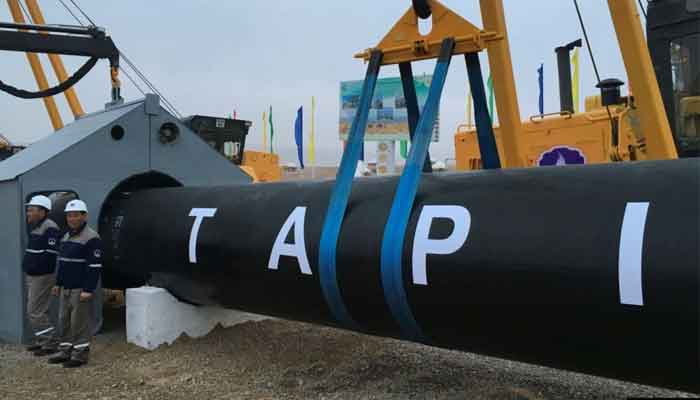TAPI gas line: Pakistan not to bear transit risk in Afghanistan

ISLAMABAD: Pakistan has told Turkmenistan in plain words that Islamabad will not bear the gas transit risk in war-ravaged Afghanistan under $8 billion TAPI gas line.
In case of halt of gas provision to Pakistan because of any subversive activity in Afghanistan, Pakistan will never take the risk at any cost, rather Turkmenistan will have to bear the risk.
More importantly, the financial commitment on behalf of Pakistan is to start when Turkmenistan ensures the gas supply on Pakistan border, not at border of Afghanistan shared with Turkmenistan. This has been clearly conveyed to Turkmenistan top authorities, top sources close to Special Assistant to Prime Minister on Petroleum Nadeem Babar told The News. Prior to it, Pakistan has already agitated with authorities of Turkmenistan the issue of reviewing the gas prices arguing that the gas price formula under which the gas prices of every buying countries (Afghanistan, Pakistan and India) has been worked out, is too much complicated and if new gas price is worked out while keeping in view the existing gas price formula, the gas price that we get is costlier even than the existing LNG price. ‘So we want Turkmenistan to review gas price formula prior to much awaited ground breaking of the portion of TAPI pipeline in the territory of Pakistan.
A high-power delegation of Turkmen Gas Company is due in Pakistan to discuss the issues raised by Pakistan. Now Turkmenistan wants, under new scenario, Pakistan experts’ delegation to come to Ashgabat and extends the date of August 11, 2019. Because of Eidul Azha the date may get changed.
“Yes, we wrote a letter to Turkmenistan authorities 7 months back seeking the dialogue for review of the gas pricing formula before embarking upon the construction of the portion of the pipeline in Pakistan’s territory and to this effect Special Assistant to PM on Petroleum Nadeem Babar asked the authorities of Turkmenistan to first review the gas prices downward before initiating the project,” a relevant top official confirmed to The News.
Coming to the new issue of bearing risk of gas provision because of Afghanistan highlighted by Pakistan that it will only honour its financial commitment when it gets the gas delivery on its border. Turkmenistan first asked Pakistan to discuss this issue with Afghanistan, but Islamabad responded saying that it is purchasing the gas from Turkmenistan and Pakistan wants gas delivery on its border. Since Afghanistan has been at war for many decades, so Pakistan cannot bear the risk of gas provision in Afghanistan.
During the recent visit, Afghanistan President Ashraf Ghani acknowledged the issue raised by Pakistan and assured that in this regard the authorities will soon meet counterparts of Afghanistan and Turkmenistan.
To a question, the top man in the Petroleum Division said that Turkmenistan has shown willingness to review gas prices.
The three buyer countries — Afghanistan, Pakistan and India — had inked the gas sales purchase agreement with Turkmenistan on bilateral basis. Now all the buyer countries want to unfold their prices and want the re-negotiations.
To a question, he said that the financial colure of the project is to be completed by September this year and ground breaking would be held in October 2019 for laying down the 800 kilometre portion of TAPI line in Pakistan territory. The project will be operational by 2020. The pipeline from Afghanistan that will enter from Chaman and pass through Zhob, DI Khan, Quetta, Multan and touch upon Fazilka — a city at Indian border which is 150 kilometer away from Multan. From Fazilka, the pipeline will enter India.
TAPI gas pipeline project aims to bring natural gas from the Gylkynish and adjacent gas fields in Turkmenistan to Afghanistan, Pakistan and India. The ADB is acting as the facilitator and coordinator for the project. It is proposed to lay a 56-inch diameter 1,680KM pipeline with design capacity of 3.2 billion cubic feet of natural gas per annum (Bcfd) from Turkmenistan through Afghanistan and Pakistan up to Pak-India border. There are two phases of this project, the first phase is free flow phase with estimated cost of $5 to $6 billion while second phase is installation of compressor stations with the cost of $1.9 to $2 billion. Civil works of the project have already commenced in Afghanistan after the project’s ground breaking (Afghan section) was held last year.
Afghanistan will be having the gas under TAPI 500 mmcfd, Pakistan 1.325 bcfd and India 1.325bcfd too. Turkmen gas company being the consortium leader for the TAPI project is to contribute up to 85 percent of equity, and the rest of TAPI members namely Afghanistan, Pakistan and India would take 5 percent each equity share in the project company.




































